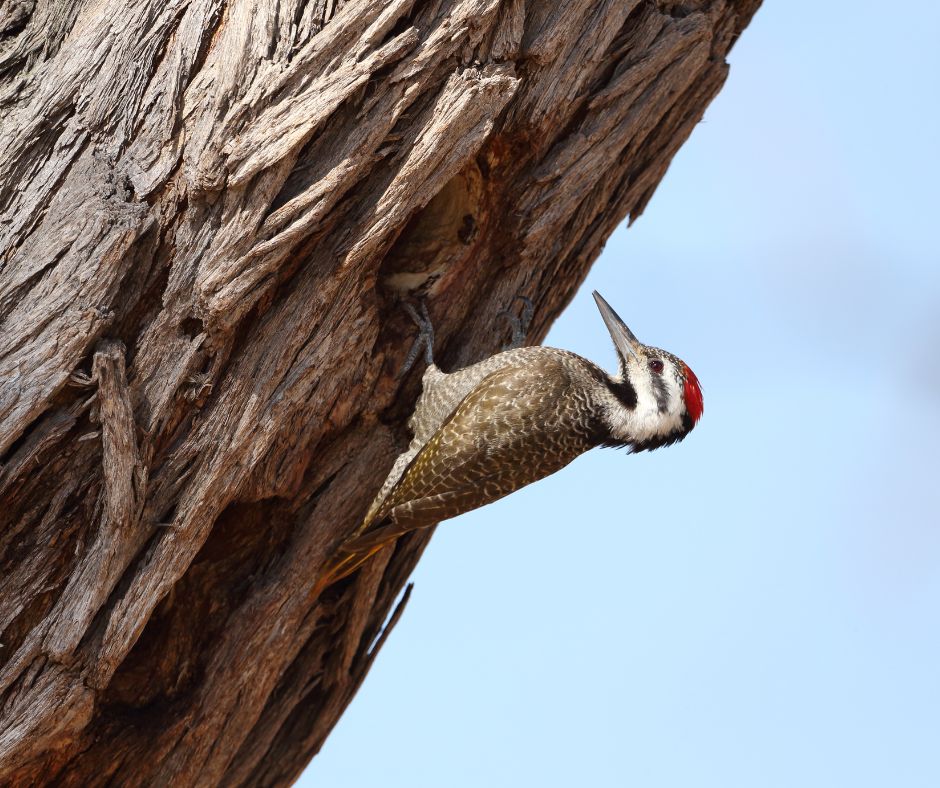 How To Keep Woodpeckers Out
How To Keep Woodpeckers Out
How To Keep Woodpeckers Out
Do you have woodpeckers damaging the side of your house in Westchester, NY? Woodpeckers are a common nuisance for homeowners, pecking and drilling away at siding, trees, wooden furniture, and even sometimes gutters and downspouts. Woodpeckers are difficult to get rid of, especially because they are protected under the Migratory Bird Treaty Act. Don’t worry, Westchester Wildlife can still help! We can provide you with exclusions and deterrents to keep woodpeckers from drilling at your home. We can also safely and humanely remove woodpeckers in accordance with laws and guidelines. Contact Westchester Wildlife to get started with a FREE estimate for woodpecker control and deterrent services in the NY/CT counties of Westchester, Putnam, Dutchess, Fairfield, and Litchfield at (800) 273-6673!
Types of Woodpeckers in CT and NY
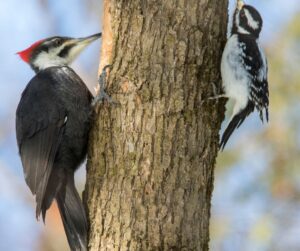 New York and Connecticut are home to many different types of woodpeckers, with these different species varying wildly in size and coloration. Some of the species you may encounter include:
New York and Connecticut are home to many different types of woodpeckers, with these different species varying wildly in size and coloration. Some of the species you may encounter include:
- Downy Woodpecker
- Hairy Woodpecker
- Yellow-bellied Sapsucker
- Northern Flicker
- Red-bellied Woodpecker
- Pileated Woodpecker
- Red-headed Woodpecker
No matter what type of woodpecker is damaging your property, Westchester Wildlife is here to help with exclusion and deterrent services.
Woodpecker Damage
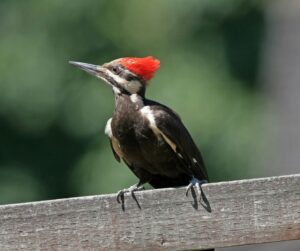 Woodpeckers feed on insects like carpenter ants and carpenter bees that spend their time inside wood, so they have evolved to have sharp, sturdy beaks with which to peck and drill rapidly at trees, creating cavities that allow them to snatch insects for a quick meal. Woodpeckers will also create cavities inside trees to make their nests. During the springtime, male woodpeckers will attract mates and mark their territory by pecking loudly at any hard surface they can find. Woodpeckers can actually be beneficial in the yard, as they are natural pest control agents that feed on insects. Problems with woodpeckers arise when they start drilling holes on the sides of houses, on decks, and on deck furniture in search of food. Additionally, woodpeckers may start pecking on gutters, downspouts, metal eaves, and your home’s siding during their mating season. Woodpecker damage doesn’t just cause unsightly damage to your property, it can also leave your home more vulnerable to water leaks and pest intrusions. Additionally, the actual drilling process can be extremely loud and annoying, and may even disrupt your sleep schedule.
Woodpeckers feed on insects like carpenter ants and carpenter bees that spend their time inside wood, so they have evolved to have sharp, sturdy beaks with which to peck and drill rapidly at trees, creating cavities that allow them to snatch insects for a quick meal. Woodpeckers will also create cavities inside trees to make their nests. During the springtime, male woodpeckers will attract mates and mark their territory by pecking loudly at any hard surface they can find. Woodpeckers can actually be beneficial in the yard, as they are natural pest control agents that feed on insects. Problems with woodpeckers arise when they start drilling holes on the sides of houses, on decks, and on deck furniture in search of food. Additionally, woodpeckers may start pecking on gutters, downspouts, metal eaves, and your home’s siding during their mating season. Woodpecker damage doesn’t just cause unsightly damage to your property, it can also leave your home more vulnerable to water leaks and pest intrusions. Additionally, the actual drilling process can be extremely loud and annoying, and may even disrupt your sleep schedule.
What Attracts Woodpeckers?
Woodpeckers are attracted to dead trees on your property, as they provide a perfect spot for them to build their nests. Woodpeckers love to eat wood destroying insects like termites, carpenter ants, carpenter bees, and wood boring beetles. If your home is infested with these pests, then woodpeckers will drill through your wooden structures to get these easy meals. If you have a bird feeder in your yard, woodpeckers will happily partake in any seeds or nuts inside. Woodpeckers are also attracted to the aluminum, tin, and other metals that might be on your roof, windows, flashing or gutters as they amplify their pecking sound, which is how woodpeckers communicate.
Woodpecker Deterrent
Woodpeckers are federally protected under the Migratory Bird Treaty Act, and must be handled with care. The best way to deal with a woodpecker problem is to deter them from your property. Bird spikes installed on high traffic areas will prevent them from landing, and installing bird netting will keep them out of your yard altogether. Scaring and hazing woodpeckers can also be effective, especially when two or more techniques are used at the same time. A good pest control program for your property can eliminate food sources for woodpeckers, which will cause them to move on from your home faster.
Woodpecker Control from Westchester Wildlife
Removal of woodpeckers from your property should be an absolute last resort, and you should never attempt to remove them yourself, as woodpeckers are federally protected. Always leave woodpecker removal to the experts at Westchester Wildlife. Our team can also seal off and fortify any holes that woodpeckers drilled into your home. Contact us to get started today with a FREE estimate at (800) 273-6673!
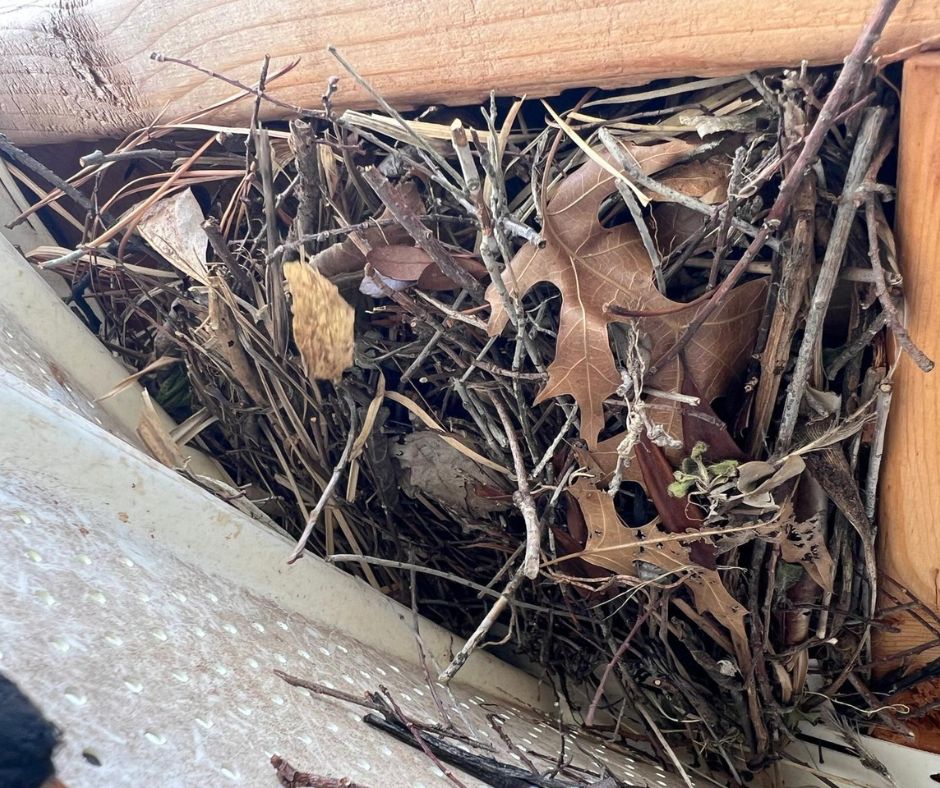 How To Prevent Wildlife from Entering Your Home as Temperatures Drop
How To Prevent Wildlife from Entering Your Home as Temperatures Drop
How To Prevent Wildlife from Entering Your Home as Temperatures Drop
Fall is here, and as the temperatures drop, nuisance pests and wildlife will be searching for ways to get inside your home in the Westchester, NY area. Raccoons, squirrels, birds, bats, mice, rats, and more will be searching for any potential entry point to your attic or crawl space that they can fit through, searching for a warm place to spend the winter, safe from the freezing temperatures. It’s important that your home is fortified against these critters for the fall, as once they get inside your home, they can spread diseases like rabies and cause catastrophic damage to your attic insulation. If you need wildlife removal or exclusion services in the Westchester area, contact the experts at Westchester Wildlife. Our team has years of experience dealing with nuisance wildlife, and you can rest assured that we will safely and humanely remove and exclude these critters from your property.
Wildlife in the Attic in the Fall
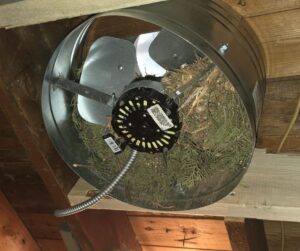 Your attic space is prime real estate for squirrels, raccoons, bats, birds, and more, especially as the temperatures cool down. Attic spaces provide safe, warm, secluded nesting areas that can protect against the harsh winter temperatures. Squirrels and raccoons will shred your insulation to create their nests, often soiling it in the process with urine and feces. Raccoons will dig latrines for their droppings, but squirrels will just go wherever, and the smell of their droppings can attract more squirrels to the attic. Raccoons in your attic can also tear through your HVAC ducts, and squirrels will gnaw on everything in sight, including the rubber covering around wires which can pose a fire risk. Squirrels also create a fire risk by bringing in outside nesting material, and birds nesting in your attic will do the same. Bats will roost from your rafters or gable vents, depositing large amounts of guano into your insulation over time. Bat guano contains the spores that cause the fungal lung infection histoplasmosis, and these spores can get stirred up in the air when the guano is removed, so always leave guano cleanup to the professionals. The best way to prevent animals from getting inside your attic in the fall is to carefully inspect your attic, and make sure all entry points are sealed and fortified to prevent anything from getting inside.
Your attic space is prime real estate for squirrels, raccoons, bats, birds, and more, especially as the temperatures cool down. Attic spaces provide safe, warm, secluded nesting areas that can protect against the harsh winter temperatures. Squirrels and raccoons will shred your insulation to create their nests, often soiling it in the process with urine and feces. Raccoons will dig latrines for their droppings, but squirrels will just go wherever, and the smell of their droppings can attract more squirrels to the attic. Raccoons in your attic can also tear through your HVAC ducts, and squirrels will gnaw on everything in sight, including the rubber covering around wires which can pose a fire risk. Squirrels also create a fire risk by bringing in outside nesting material, and birds nesting in your attic will do the same. Bats will roost from your rafters or gable vents, depositing large amounts of guano into your insulation over time. Bat guano contains the spores that cause the fungal lung infection histoplasmosis, and these spores can get stirred up in the air when the guano is removed, so always leave guano cleanup to the professionals. The best way to prevent animals from getting inside your attic in the fall is to carefully inspect your attic, and make sure all entry points are sealed and fortified to prevent anything from getting inside.
Dangers of Wildlife in your Chimney
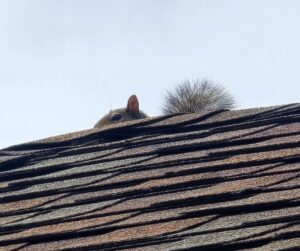 Your chimney also provides a good nesting place for raccoons, squirrels, bats, and birds. Similar to the attic space, your chimney provides a safe, warm, secluded place where these critters can hide from the cold. However, your chimney often provides direct access to your home, and these critters often carry diseases and parasites that they can transmit to you and your pets, including rabies, histoplasmosis, tularemia, leptospirosis, raccoon roundworm, fleas, ticks, bat bugs, and bird mites. Additionally, the nesting material that squirrels and birds bring into your attic can create a potential fire hazard, especially when the chimney is in use.
Your chimney also provides a good nesting place for raccoons, squirrels, bats, and birds. Similar to the attic space, your chimney provides a safe, warm, secluded place where these critters can hide from the cold. However, your chimney often provides direct access to your home, and these critters often carry diseases and parasites that they can transmit to you and your pets, including rabies, histoplasmosis, tularemia, leptospirosis, raccoon roundworm, fleas, ticks, bat bugs, and bird mites. Additionally, the nesting material that squirrels and birds bring into your attic can create a potential fire hazard, especially when the chimney is in use.
Rodent Activity in Fall: What Homeowners Need to Know
As the temperatures cool down in the fall, mice and rats will also be looking to invade your home in search of warmth and food. Make sure that you keep food in your pantry stored in sealed, airtight containers, as mice and rats will tear through soft plastic to eat your prepackaged food. Make sure you clean up crumbs or spills as soon as they happen, as these can also attract rodents, who will run across your food preparation services, leaving behind urine and droppings and spreading diseases like salmonella and hantavirus. When rats and mice get into your attic, they will chew through the rubber covering around wires, which can cause a house fire. Mice will also tunnel through your insulation, severely reducing its ability to resist heat. Mice and rats breed extremely quickly, and an infestation can get out of hand fast. As soon as you notice signs of rodents in your home, contact the rodent control experts at Westchester Wildlife. We can get your rodent infestation under control and provide you with seal-outs to ensure they don’t come back.
Inspecting and Sealing Entry Points
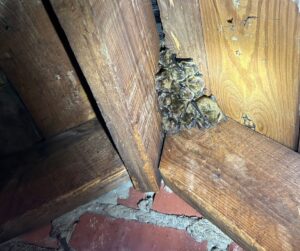 The best way to prevent raccoons, squirrels, birds, bats, mice, and rats from getting inside your home during the fall is to have a licensed wildlife removal company like Westchester Wildlife carefully inspect your home for potential entry points, then seal and fortify them. Squirrels and raccoons will search for tiny cracks and gaps inside your roof, soffit, fascia, or rake board, and then widen these holes with their claws and teeth to gain entry to the attic. Bats can enter through similar gaps, and bats can also enter through gable vents in your attic that aren’t properly sealed. Sealing off your chimney with a chimney cap will allow it to function as normal, but will also keep critters out. Entry points for rodents can be anywhere, so make sure your doors and windows are sealed and equipped with screens, and look for smaller places like where utility lines enter the home. Call Westchester Wildlife to get started with exclusion work for your home this fall at (914) 760-5713!
The best way to prevent raccoons, squirrels, birds, bats, mice, and rats from getting inside your home during the fall is to have a licensed wildlife removal company like Westchester Wildlife carefully inspect your home for potential entry points, then seal and fortify them. Squirrels and raccoons will search for tiny cracks and gaps inside your roof, soffit, fascia, or rake board, and then widen these holes with their claws and teeth to gain entry to the attic. Bats can enter through similar gaps, and bats can also enter through gable vents in your attic that aren’t properly sealed. Sealing off your chimney with a chimney cap will allow it to function as normal, but will also keep critters out. Entry points for rodents can be anywhere, so make sure your doors and windows are sealed and equipped with screens, and look for smaller places like where utility lines enter the home. Call Westchester Wildlife to get started with exclusion work for your home this fall at (914) 760-5713!
Fall Yard Cleanup to Deter Wildlife
Habitat modification in your yard can also prevent critters from setting up shop in your home. Bat houses are small structures that provide a roosting place for bats other than your attic, and these structures can be easily placed on trees in your yard, attracting bats that might otherwise become a nuisance. Fall is the season of falling leaves, but letting these leaves accumulate in large piles on your lawn provides easy cover for lawn-killing pests like moles and voles, rodents like mice and rats, and predators like snakes. Make sure that leaves are regularly raked, bushes and overgrown plants are trimmed regularly, and the grass is cut short. Keeping your lawn tidy will make critters feel exposed and unsafe in your yard, keeping them from causing any damage to your property.
The Benefits of Wildlife-Proofing Your Home for Fall
As the falling leaves and cooler temperatures of autumn arrive, it’s important to make sure that you are taking measures to keep the wildlife out of your home. Critters like raccoons, squirrels, bats, birds, rats, mice, and more will break their way into your home through your attic, chimney, or crawl space, cause extensive damage to your roof, insulation, or property, spread diseases and parasites, and even create potential fire risks. The best way to keep animals out of your home is to make sure all potential entry points are sealed and fortified. That’s where Westchester Wildlife comes in. Our team can carefully inspect all areas of the property, locate potential entry points, and then perform exclusion work, ensuring that they can’t come back. We also offer wildlife trapping and removal services in Westchester, Putnam, Dutchess, and Fairfield. Contact our team to get started with a FREE estimate at (800) 273-6673.
